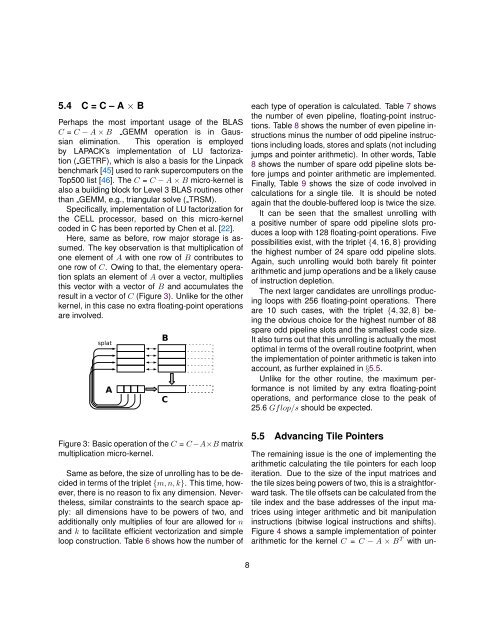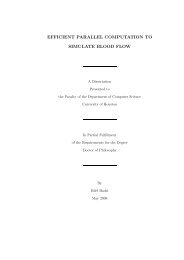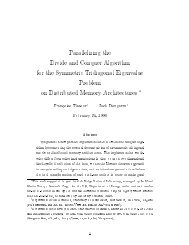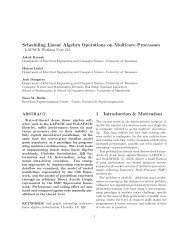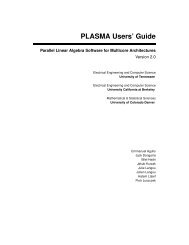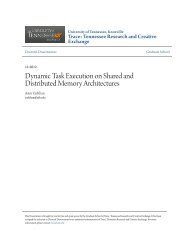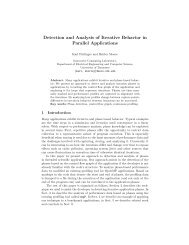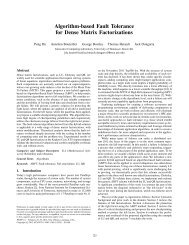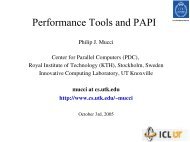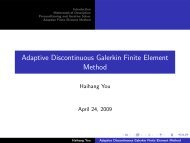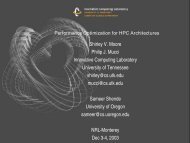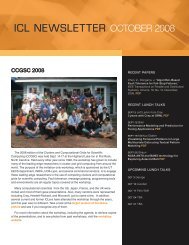Fast and Small Short Vector SIMD Matrix Multiplication ... - The Netlib
Fast and Small Short Vector SIMD Matrix Multiplication ... - The Netlib
Fast and Small Short Vector SIMD Matrix Multiplication ... - The Netlib
Create successful ePaper yourself
Turn your PDF publications into a flip-book with our unique Google optimized e-Paper software.
5.4 C = C – A × B<br />
Perhaps the most important usage of the BLAS<br />
C = C − A × B GEMM operation is in Gaussian<br />
elimination. This operation is employed<br />
by LAPACK’s implementation of LU factorization<br />
( GETRF), which is also a basis for the Linpack<br />
benchmark [45] used to rank supercomputers on the<br />
Top500 list [46]. <strong>The</strong> C = C − A × B micro-kernel is<br />
also a building block for Level 3 BLAS routines other<br />
than GEMM, e.g., triangular solve ( TRSM).<br />
Specifically, implementation of LU factorization for<br />
the CELL processor, based on this micro-kernel<br />
coded in C has been reported by Chen et al. [22].<br />
Here, same as before, row major storage is assumed.<br />
<strong>The</strong> key observation is that multiplication of<br />
one element of A with one row of B contributes to<br />
one row of C. Owing to that, the elementary operation<br />
splats an element of A over a vector, multiplies<br />
this vector with a vector of B <strong>and</strong> accumulates the<br />
result in a vector of C (Figure 3). Unlike for the other<br />
kernel, in this case no extra floating-point operations<br />
are involved.<br />
splat<br />
A<br />
B<br />
C<br />
each type of operation is calculated. Table 7 shows<br />
the number of even pipeline, floating-point instructions.<br />
Table 8 shows the number of even pipeline instructions<br />
minus the number of odd pipeline instructions<br />
including loads, stores <strong>and</strong> splats (not including<br />
jumps <strong>and</strong> pointer arithmetic). In other words, Table<br />
8 shows the number of spare odd pipeline slots before<br />
jumps <strong>and</strong> pointer arithmetic are implemented.<br />
Finally, Table 9 shows the size of code involved in<br />
calculations for a single tile. It is should be noted<br />
again that the double-buffered loop is twice the size.<br />
It can be seen that the smallest unrolling with<br />
a positive number of spare odd pipeline slots produces<br />
a loop with 128 floating-point operations. Five<br />
possibilities exist, with the triplet {4, 16, 8} providing<br />
the highest number of 24 spare odd pipeline slots.<br />
Again, such unrolling would both barely fit pointer<br />
arithmetic <strong>and</strong> jump operations <strong>and</strong> be a likely cause<br />
of instruction depletion.<br />
<strong>The</strong> next larger c<strong>and</strong>idates are unrollings producing<br />
loops with 256 floating-point operations. <strong>The</strong>re<br />
are 10 such cases, with the triplet {4, 32, 8} being<br />
the obvious choice for the highest number of 88<br />
spare odd pipeline slots <strong>and</strong> the smallest code size.<br />
It also turns out that this unrolling is actually the most<br />
optimal in terms of the overall routine footprint, when<br />
the implementation of pointer arithmetic is taken into<br />
account, as further explained in §5.5.<br />
Unlike for the other routine, the maximum performance<br />
is not limited by any extra floating-point<br />
operations, <strong>and</strong> performance close to the peak of<br />
25.6 Gflop/s should be expected.<br />
Figure 3: Basic operation of the C = C−A×B matrix<br />
multiplication micro-kernel.<br />
Same as before, the size of unrolling has to be decided<br />
in terms of the triplet {m, n, k}. This time, however,<br />
there is no reason to fix any dimension. Nevertheless,<br />
similar constraints to the search space apply:<br />
all dimensions have to be powers of two, <strong>and</strong><br />
additionally only multiplies of four are allowed for n<br />
<strong>and</strong> k to facilitate efficient vectorization <strong>and</strong> simple<br />
loop construction. Table 6 shows how the number of<br />
5.5 Advancing Tile Pointers<br />
<strong>The</strong> remaining issue is the one of implementing the<br />
arithmetic calculating the tile pointers for each loop<br />
iteration. Due to the size of the input matrices <strong>and</strong><br />
the tile sizes being powers of two, this is a straightforward<br />
task. <strong>The</strong> tile offsets can be calculated from the<br />
tile index <strong>and</strong> the base addresses of the input matrices<br />
using integer arithmetic <strong>and</strong> bit manipulation<br />
instructions (bitwise logical instructions <strong>and</strong> shifts).<br />
Figure 4 shows a sample implementation of pointer<br />
arithmetic for the kernel C = C − A × B T with un-<br />
8


